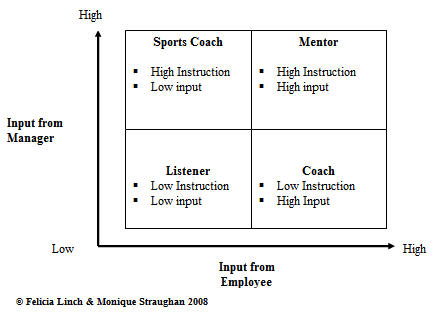We’ve had a few calls for coaching recently. Have you noticed how coaching’s never really gone away? It’s somehow managed to survive being relegated as a ‘fad’ when ‘Life Coaches’ became popular. So why is that?
Well perhaps it’s because coaching seems to have been around in some form since before time itself…well not really, but it’s definitely been around for a while. According to Performance Coaching Int’l http://www.performancecoachinginternational.com/ we can trace the roots of coaching right from days of yore when the more experienced and skilled elders would teach the young how to hunt, cook, paint pictures on cave walls and to contribute effectively to their communities in general.
Fast-forward a few hundred centuries and Performance Coaching Int’l attribute a noticeable increase in interest in coaching, to the transition of society from a collective to an ‘individual’ focus. This aligns with the changes in development –interventions which moved from the sheep-dip approach, prevalent in the 1990’s, to tailored and individualized solutions that are common today.
A major breakthrough in coaching came in the guise of the published work of a former motor racing champion, Sir John Whitmore. His publication ‘Coaching for Performance’ (2002) gave the world the now famous GROW model (Goal, Reality, Options, Will). His simple approach helped to open the floodgates for what has become a billion dollar industry in both the US and UK markets.
Over the last 15 years numerous other coaching approaches have emerged with some attempting to make it more ‘sophisticated’, and in our opinion overcomplicating it! Whichever approach you favour the underlying ethos remains the same. Coaching is essentially:
‘an intuitive developmental tool that facilitates the individual arriving at their own solution with learning being the ultimate outcome’. (Monique Straughan & Felicia Linch 2008)
“But” we hear you say – “this doesn’t fit our definition of a coach”. Perhaps you are more familiar with the ‘sports coach’ who gives more instruction and there is less input from the individual, or the ‘mentor’. These classifications are used interchangeably at times and often without being defined so instead of bringing clarity to the Coaching debate they muddy the waters. So we have designed a useful model which is our attempt at distinguishing and understanding these different classifications, and the respective value of each:
The Listener: this is where instruction from the manager is low and input from the employee is low. This could be considered the most ineffectual of all the classifications as basically the employee is given the opportunity to vent but no problem solving/guidance is forthcoming.
The Sports Coach: this is where there is high instruction from the manager and low input from the employee. This relationship may be of value but we suggest is more suited to employees with limited/no work experience, or in a non-work environment such as youth clubs, educational institutions.
The Mentor: this is where there is high instruction from the manager, but also high in put from the employee. This relationship also has some value and may be the initial stages of a ‘Coaching’ relationship as the employee gains confidence and realises that they have the answers within them. Another distinguishing factor with a mentor is that their scope often extends beyond job-development and therefore it is recommended that a mentor be someone other than the direct line manager.
The Coach: this is where there is low instruction from the manager, and high input from the employee. Here the coach questions and challenges, rather than ‘tells’ the employee what to do. We believe the learning is much more effective when the employee has arrived at the answer themselves verses having it handed to them, not to mention the fact that if it all goes horribly wrong the employee has to take some responsibility rather than just pointing the finger at the coach!
So there you have it – Coaching and the classifications defined. Next week we take a look at the basic coaching process, and more importantly the value, or not, that it delivers to businesses.
[email_link]


I enjoyed the view shared on Coaching and the thoughts expressed on what it was and is evolving towards. Now that I have been back in the US for a year, after ten years in the Caribbean I have done a bit of my own research on the topic. After years of providing Execuitve and Life Coaching, it has evolved into a number of specialties but most with the same basic framework and belief system. After 16 years as a Psychotherapist with an eccletic style of supporting personal growth in others, we can see that Coaching today is very similar to some of the Structural Strategic Methods of Family Treatment often associated with the Italian model of brief, behavioral-solution orientation, developed decades ago. Coaching has become a profitable profession and has evolved to merit national and intenational certification via organizations such as the International Coaching Federation which has very stringent requirements, and, justifiably so. My experience in the Caribbean tells me that Coaching has much potential and is perhaps where Employee Assistance Programs were some ten years ago and which have become gradually more acceptable, although, in my view, under promoted and still under utilized in the Region. (Marco Nozicka, LCSW, President,The PeopleWorks Group, Inc.)
Marco,
thyanks for your contribution. It’s interesting what you say about the Pyschcological approach/link with Coaching. I guess my question is that if this is the evolution of Coaching, despite certification now becoming the norm in the US and the U.K. is that enough as this type of certification is not based/grounded in Psychology. Do you think having that knowledge/background is a must (i.e. its dangerous if one doesn’t have it) or just desireable.
Kind Regards
Felicia